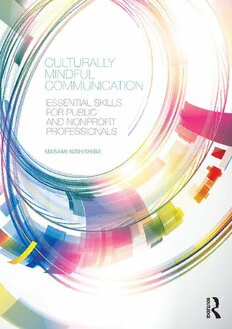
Culturally Mindful Communication: Essential Skills for Public and Nonprofit Professionals PDF
Preview Culturally Mindful Communication: Essential Skills for Public and Nonprofit Professionals
CULTURALLY MINDFUL COMMUNICATION Intercultural communication is a necessary skill for those who work in the public and nonprofit sectors, and yet there is a dearth of literature available to help public and nonprofit professionals to effectively communicate,interact,andleadinamulticulturalsociety.Drawingon research in intercultural communication, psychology, and public and nonprofit administration, Culturally Mindful Communication provides practical strategies for students and practitioners of public service to improve their intercultural communication skills. Topics include: (cid:1) Expectations for public and nonprofit professionals in today’s multicultural society (cid:1) Frameworks to assess cultural differences and similarities (cid:1) Verbal and nonverbal communication in intercultural contexts (cid:1) Stereotyping, prejudice, ethnocentrism, microaggression, and socialprivilegeasbarrierstoeffectiveinterculturalcommunication (cid:1) Key considerations for effective multicultural teams (cid:1) Approaches for effective multicultural community engagement (cid:1) Leading with cultural mindfulness Masami Nishishiba is Chair and Associate Professor in the Depart- mentofPublicAdministration,andAssociateDirectoroftheCenterfor PublicServiceattheMarkO.HatfieldSchoolofGovernment,Portland StateUniversity. This page intentionally left blank CULTURALLY MINDFUL COMMUNICATION Essential Skills for Public and fi Nonpro t Professionals Masami Nishishiba Firstpublished2018 byRoutledge 711ThirdAvenue,NewYork,NY10017 andbyRoutledge 2ParkSquare,MiltonPark,Abingdon,OxonOX144RN RoutledgeisanimprintoftheTaylor&FrancisGroup,aninforma business ©2018Taylor&Francis TherightofMasamiNishishibatobeidentifiedasauthorofthis workhasbeenassertedbyherinaccordancewithsections77 and78oftheCopyright,DesignsandPatentsAct1988. Allrightsreserved.Nopartofthisbookmaybereprintedor reproducedorutilizedinanyformorbyanyelectronic, mechanical,orothermeans,nowknownorhereafterinvented, includingphotocopyingandrecording,orinanyinformation storageorretrievalsystem,withoutpermissioninwritingfrom thepublishers. Trademarknotice:Productorcorporatenamesmaybetrademarks orregisteredtrademarks,andareusedonlyforidentificationand explanationwithoutintenttoinfringe. LibraryofCongressCataloginginPublicationData Acatalogrecordforthisbookhasbeenrequested ISBN:978-0-7656-4400-8(hbk) ISBN:978-0-7656-4401-5(pbk) ISBN:978-1-315-27734-9(ebk) TypesetinStoneSans byTaylor&FrancisBooks To my parents Akiko and Tetsuo Kawai For letting me be me 碧き眸の少女も引くや初みくじ New Year’s day, a girl with blue eyes asks her fortune to the Japanese god. 異国にて十年(ととせ)過ぎし娘(子)雲の峰 Summer clouds, Ten years in foreign land Floats by with my daughter. – 河合哲朗 句 By Tetsuo Kawai (Translation by Masami Nishishiba) This page intentionally left blank CONTENTS List of illustrations viii Acknowledgment xi About the author xiii 1 Introduction: Why do public and nonprofit professionals need to be culturally mindful communicators? 1 2 Understanding cultural differences 12 3 Understanding the intercultural communication process 32 4 Verbal communication 50 5 Nonverbal communication 67 6 What hinders culturally mindful communication? Stereotyping, prejudice, and social privilege 104 7 Working in a multicultural team 127 8 Working with multicultural stakeholders in the community 151 9 Leading with culturally mindful communication 169 Index 190 vii LIST OF ILLUSTRATIONS Figures 1.1 Breakdown of non-white American: 1960, 2010 5 1.2 Projected change in the US workforce demographics 7 2.1 Illustration of individualism vs. collectivism 20 2.2 Illustration of high vs. low power distance 23 2.3 Key contrasts between high vs. low uncertainty avoidance 24 2.4 Schematic illustration of the high- vs. low-context orientation 25 2.5 Key contrasts between monochronic vs. polychronic time orientation 27 3.1 Schematic illustration of intercultural communication process 35 3.2 The intercultural communication process 37 3.3 Differences in attribution between ingroup and outgroup for positive and negative outcomes 43 4.1 Books (collections of printed pages bound together along one side) 52 4.2 Hiroshima Memorial Cenotaph 59 5.1 OK sign 70 5.2 Bowing 70 5.3 Handshake 71 viii Listofillustrations 5.4 “Don’t know” 75 5.5 “Stop!” 75 5.6 “Be quiet” 76 5.7 Japanese seal 76 5.8 Turn-requesting signal 82 5.9 Turn-yielding signal 82 5.10 Turn-maintaining signal 83 5.11 Back-channel signal 83 5.12 Ritualistic touch – handshake 85 5.13 Ritualistic touch – hug 86 5.14a Physical appearance that is appropriate for a professional setting 94 5.14b Physical appearance that is inappropriate for a professional setting 95 6.1 Proportion of Mexican immigrants in different occupations 108 6.2 Comparison of household income and personal earnings between Mexican, Asian, and all immigrants 108 6.3 Proportion of Mexican, Asian, and other immigrants at different educational attainment levels 108 6.4 World map commonly seen in Japan 111 6.5 World map commonly seen in the United States 111 7.1 Leo’s note 128 7.2 Five conflict-handling styles 141 8.1 T-Horse 160 9.1 Process and components of culturally mindful communication 178 9.2 Lavita’s analysis of her interaction with Marilyn 184 9.3 Continuous improvement cycle for culturally 185 mindful communication process Boxes 2.1 Cultural moments: I’m just an intern 21 2.2 Cultural moments: I thought I was monochronic 27 ix
